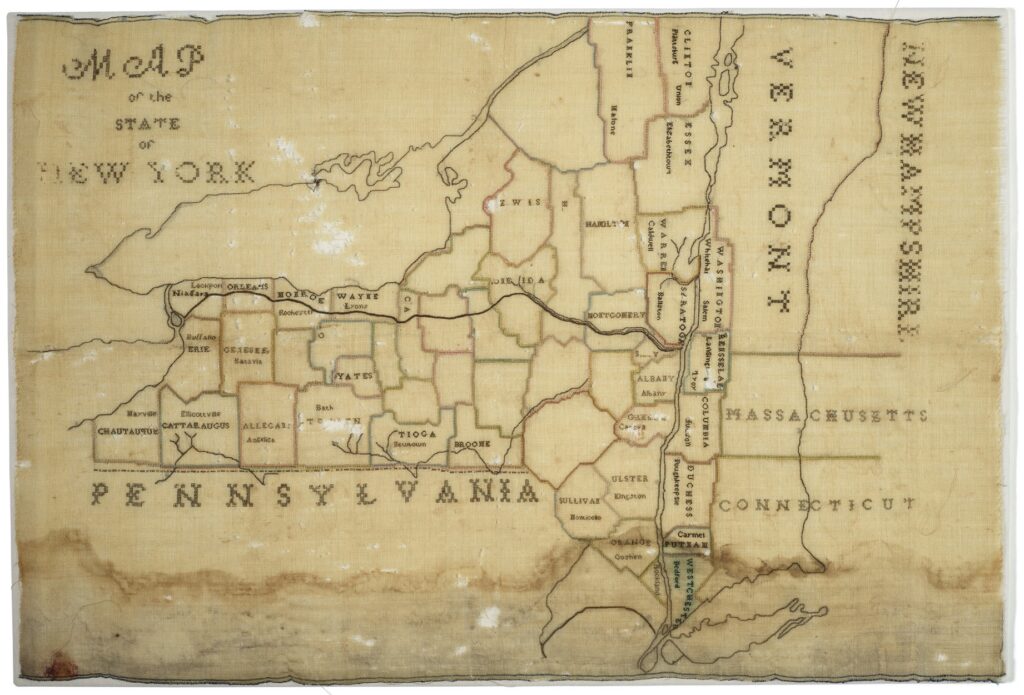
Stitched with multicolored silk thread on a wool ground fabric, this sampler shows a map of New York. It was made by Catalina Juliana Mason, a teenage girl from Puerto Rico who completed her education in Massachusetts and New York. Her father, Sidney Mason, was a merchant from Massachusetts and, later, a consul for the United States in Puerto Rico. Her mother, Marequita Benito Dorado Mason, was the daughter of a Spanish government official and a native of Puerto Rico.
Although Catalina’s father had built a life for himself in Puerto Rico, he wanted to educate his children in New England. By 1834, Catalina and her brother Alphonso had left the only home they had known and settled in Massachusetts with their family.
Catalina’s parents enrolled her in a nearby boarding school run by the Ursuline nuns in Charlestown. Unfortunately, in August of 1834, a group of anti-Catholic rioters burned the school to the ground. Catalina later remembered being rescued by a man who tossed her over a wall into the safety of a potato patch.
Not long after this disaster, Catalina endured the loss of her mother. She briefly returned to Puerto Rico in 1836 where she completed another sampler, which celebrated the new Queen of Spain, Isabel II. Her father then placed her at another school, Emma Willard’s Troy Female Seminary in New York. Although it is unclear whether Catalina made her sampler here, Willard was a pioneer of nineteenth-century geography education. In the atlases and textbooks which she authored and co-authored, she prompted students to begin their study of geography with the town in which they lived and then move outward to their county, state, country, and continent. This strategy went against the prevailing idea that students should begin by studying the globe and work inward. Catalina stayed at the Troy Female Seminary for two years. She later attended school at an academy run by the Misses McClenachans in New York City.
Many girls stitched map samplers in the United States during the late eighteenth and early nineteenth centuries. Most of these girls depicted the entire globe, the western hemisphere, the North American continent, or the United States. A few, like Catalina, stitched state maps. In 1829, another girl, Elizabeth Ann Goldin, stitched a map of New York that looks very similar to Catalina’s. It’s possible that Elizabeth went to the same school or used the same printed map as a pattern. Map samplers were a way for girls to display their knowledge of geography and skill at needlework; they were also a way for their parents to display their wealth. Map samplers were expensive to produce; parents not only had to pay for yards of silk thread, but they also had to pay for months, if not years, of instruction in both geography and needlework. By the time Catalina stitched her sampler however, the practice was going out of fashion. Rather than spend so much time and money on large projects like map samplers, parents and instructors wanted students to focus on more “useful” tasks.
What can Catalina’s map sampler tell us about her? Although we don’t know where she stitched this sampler, we do know that she received instruction at the Troy Female Seminary and likely took lessons in geography there. At Troy, she would have learned to begin with the local and expand outward; it would therefore seem logical to stitch a map of the state in which she lived. But was this really her “local” geography? Was this her home? This sampler can only tell us part of Catalina’s story, which spanned miles of land and sea. She lived in a vast, interconnected world, and this sampler only shows a small part of it.
-Emily Wells
Junior Girl
Girl Museum Inc.
